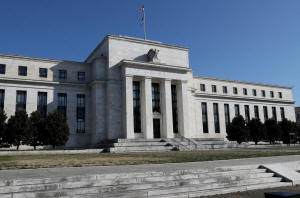Fed set for big rate hike as waters get choppy for world's central banks
 Send a link to a friend
Send a link to a friend
 [September 21, 2022]
By Howard Schneider [September 21, 2022]
By Howard Schneider
WASHINGTON (Reuters) - The Federal Reserve
is expected on Wednesday to lift interest rates by three-quarters of a
percentage point for a third straight time and signal how much further
and how fast borrowing costs may need to rise to tame a potentially
corrosive outbreak of inflation.
The policy decision, due to be announced at 2 p.m. EDT (1800 GMT), will
mark the latest move in a synchronized policy shift by global central
banks that is testing the resilience of the world's economy and the
ability of countries to manage exchange rate shocks as the value of the
dollar soars.
While investors largely expect the Fed to lift its policy rate by 75
basis points to the 3.00%-3.25% range, markets could be unsettled by the
updated quarterly economic projections that will be released along with
the policy statement.
Those projections will show where Fed policymakers think interest rates
are heading, how long it will take inflation to fall, and how much
"pain" is likely to be inflicted on U.S. employment and economic growth
along the way.

If the past few months are any prologue, that rewritten economic script
will point to a tougher-than-expected fight ahead, with a federal funds
rate that may top 4% by the end of 2022, versus the 3.4% that was
expected when the last set of projections were issued in June, and
rising unemployment.
"With little evidence in hand that inflation pressures are abating,
(Chair Jerome Powell) is likely to re-emphasize the Fed's commitment to
do what is necessary to bring inflation to target, even if that means
risking a recession," Deutsche Bank economists wrote late last week.
"They will ... foresee tighter monetary policy and greater pain in the
labor market."
Deutsche Bank expects the U.S. central bank to eventually need to raise
its policy rate to around 5.00%, a level approaching the peak of 5.25%
seen from mid-2006 to 2007 when Fed policymakers were concerned about a
bubble in the U.S. housing market, and one that could amplify stress
across the global financial system.
Powell is scheduled to hold a news conference at 2:30 p.m. to elaborate
on the latest policy decision, and his tone will shape whether it is
interpreted as a hawkish next step with more of the same ahead, or as a
final bit of rate-hike "front-loading" before the Fed reverts to more
conventional rate increases of 50 or 25 basis points as it feel its way
to a stopping point.
Powell has had to correct himself in real time about the Fed's likely
path twice this year. In June, after he largely ruled out hiking rates
by three-quarters of a percentage point, a surprise jump in inflation
unnerved the policymaking Federal Open Market Committee and pushed its
members towards the larger increase. In July, Powell's comment that the
Fed might move to smaller incremental rate increases was read as
indicating an imminent policy pivot.
[to top of second column] |

Federal Reserve Board building on
Constitution Avenue is pictured in Washington, U.S., March 19, 2019.
REUTERS/Leah Millis/File Photo

The Fed chief's tone since then has become ardently hawkish, and,
with the central bank's preferred measure of inflation running more
than three times its 2% target, another dose of tough talk is
anticipated.
"Risks still skew toward higher terminal policy rates and we expect
a relatively hawkish FOMC meeting," Citi economists wrote on
Tuesday.
'PRESENT DANGER'
The hawkish stance has become the norm globally as central bankers
dial up interest rate moves not seen since the 1990s, at the tail
end of a fight in the developed world against inflation that had
become entrenched in the 1970s.
The European Central Bank, following the Fed, earlier this month
raised its key interest rate by three-quarters of a percentage point
for the first time ever; Sweden's central bank this week approved
its first full-percentage-point increase in 30 years.
The Bank of England and the central banks of Switzerland and Norway
will meet this week, with markets expecting them to announce large
rate hikes.
Such increases in borrowing costs can feed off each other, changing
currency, price and trade dynamics in ways that prompt other central
banks to react, particularly in emerging markets where exchange rate
fluctuations and rising dollar interest rates can cause unexpected
financial shocks.
Led by the Fed's intensifying focus on fighting inflation, the
tightening has become so pronounced that some have begun worrying
about overkill.

"Central banks nearly everywhere feel accused of being on the back
foot," in failing to anticipate to prevent the jump of inflation in
2021, Maurice Obstfeld, the former chief economist of the
International Monetary Fund, wrote in an essay last week published
by the Peterson Institute for International Economics. "The present
danger, however, is not so much that current and planned moves will
fail eventually to quell inflation. It is that they collectively go
too far and drive the world economy into an unnecessarily harsh
contraction."
Between the aftershocks from the COVID-19 pandemic and the Russian
invasion of Ukraine, World Bank President David Malpass warned last
week that the global economy could be approaching "a protracted
period of feeble growth and elevated inflation."
(Reporting by Howard Schneider; Editing by Paul Simao)
[© 2022 Thomson Reuters. All rights
reserved.]
This material may not be published,
broadcast, rewritten or redistributed.
Thompson Reuters is solely responsible for this content. |